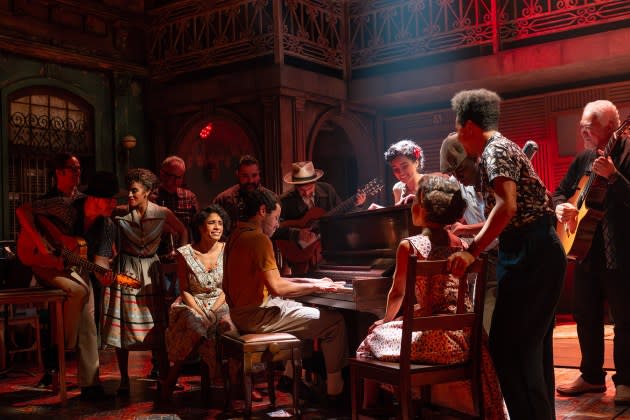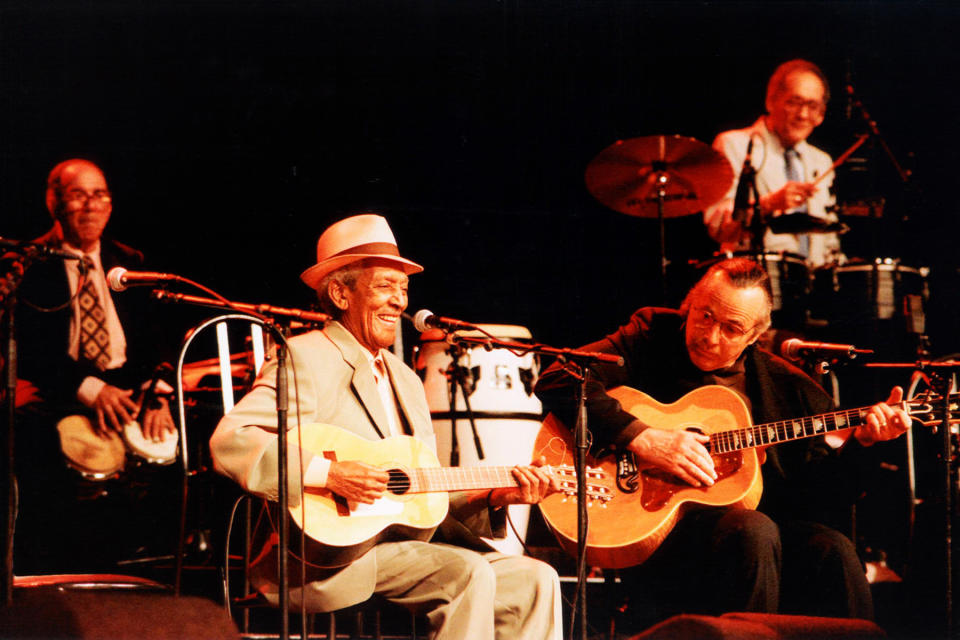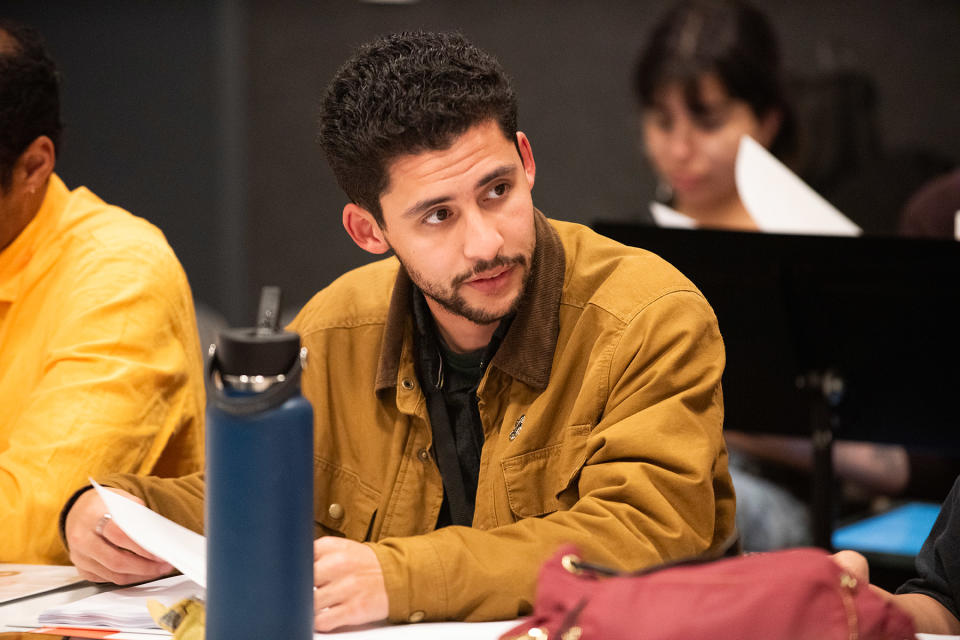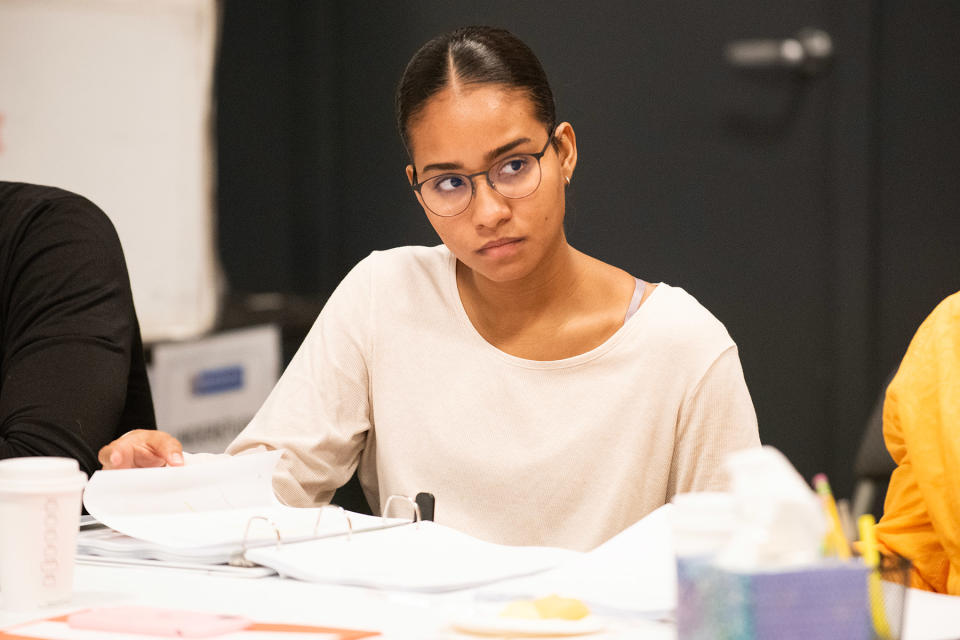‘Nothing Like This Has Been Attempted Before’: Behind the Buena Vista Social Club Musical
- Oops!Something went wrong.Please try again later.

Cuba is roughly 1,300 miles away, but in a rehearsal space in downtown Manhattan, it doesn’t feel all that far. Cradling their percussion instruments, horns, and guitars, a ten-piece band of musicians, some from Latin America, preparing to play a sinuous piece of son Cubano, as a theater crew — director, writer, actors and choreographers — hover around.
“Nothing like this has been attempted before,” says music supervisor Dean Sharenow. “It’s important that this is the real thing, not a Broadway musical production.”
More from Rolling Stone
Welcome to the next iteration of the enduring saga of the Buena Vista Social Club.
Released the same year as Radiohead’s OK Computer, Janet Jackson’s The Velvet Rope and Bob Dylan’s Time Out of Mind, Buena Vista Social Club became the least likely music phenom of 1997 — and just about any other year. A tribute to the classic son style of the Forties and Fifties, the album brought together veteran Cuban singers and musicians who’d had success in their home country but sometimes struggled after the 1959 revolution in their country. In 1996, when they were all in their sixties, seventies and eighties, they were recruited for a new album honoring that genre, under the tutelage of Ry Cooder and British producer Nick Gold of World Circuit Records. Sung entirely in Spanish, Buena Vista Social Club became the must-own album in Latino and non-Latino households alike, selling millions of copies worldwide, and winning the Best Tropical Latin Performance Grammy. In his novel Fury, Salman Rushdie referred to “that Buena Vista summer” of 1998. “When you listened to that record, it could be 20 degrees out, but it’s a sound that warmed up everything,” says playwright Marco Ramirez (The Royale, about Black boxers in Jim Crow America in the early 1900s). “It’s like aroma therapy.”
Buena Vista Social Club also spawned an unexpected cottage industry, leading to U.S. tours, offshoot albums by some of its members, and two documentaries (including Wim Wenders’ Oscar-nominated Buena Vista Social Club). “Something about that album struck a chord,” says Orin Wolf, the theatrical producer known for The Band’s Visit. “For whatever reason, you put it on and whether you speak Spanish or not, it moved people. I can’t point to one reason why this thing became what it became. But it’s astonishing how much of a brand it’s become.”
Since those heady days, many of the original members of the ensemble — bolero singer Ibrahim Ferrer, guitarist and singer Compay Segundo, pianist Rubén González and bassist Orlando López — have passed way. But is there a future for the Buena Vista Social Club franchise, and can it appeal to a generation that was barely born when the album made its splash a quarter century ago? That question may be answered with its next variation: a musical.
Opening in mid-December for a limited month-long run in New York, Buena Vista Social Club will not only tell the story of the Nineties recording session that begat the album (a happy accident in and of itself) but also the backstory of many of its principal players — including the regal singer Omara Portuondo, already a star in her home country before she became part of the Nineties ensemble. Juan de Marcos Gonzalez, the younger Cuban musician who brought all the musicians and singers together for the album, is also a central character. Says Ramirez, who wrote the musical’s book, “This is about Juan knocking on doors and saying, ‘We have seven days to make a record and come with me on this adventure.'”
Arriving at a finished product based on a 26-year-old album, though, was challenging even by the standards of mounting a costly musical. Wolf, who had the idea in 2017, says he was “always fascinated by Cuba as a place and culture and its relationship with the United States and the West.” He reached out to Gold and World Circuit, the U.K.-based label that recorded the album, which has owned the trademark since 1999. According to Wolf, Gold had already rebuffed attempts to turn the story into a feature film or two. “He was very cautious,” says Wolf. “Nick has always been protective, so at first he was resistant.” (Neither Gold nor Cooder were available for comment.) After Gold had traveled to New York and seen The Band’s Visit, according to Wolf, he changed his mind, and the theatrical reboot would proceed. (If there’s any doubt what a brand it has become, the title of the musical includes a trademark symbol.)
Somewhat mirroring Wenders’ film, the stage Buena Vista Social Club alternates between depictions of the album sessions with flashbacks to the musicians in the Fifties. Different actors play young and older versions of the crew, sometimes crossing each other on stage. “I knew the Nineties had to be the focus,” says Ramirez. “But what are the old grudges and heartbreaks in the musicians?” Ramirez says the show also takes a degree of creative license with the characters, making some of the musicians feel less recognized in their later years than they were. “We’re making them less well known in Cuba so when it all happens, it’s a big deal,” says Ramirez. “We want to dramatize the underdog story.”

The musical’s team then made the decision to make the show as authentic as possible, which was easier said than cast. The dialogue would be in English, but the songs (taken from the original album but some taken from the solo projects) would remain in Spanish. “It would have felt wrong to translate the songs into English,” says creative consultant David Yazbek. “To hear these people singing these beautiful songs written to be sung in Spanish, but then translated, would be so corny.” Some of those lyrics are pained love songs, but others, even Yazbek admits, are sillier. “When people look up the lyrics of ‘Chan Chan,'” he laughs of the album’s most popular tune, “they’re like, ‘Huh?’ There’s a lot of innuendo and some directions!”
Jared Machado, who plays the youthful Segundo, has Cuban roots (his father was born there), but was himself raised in the States. For him and others, singing those sings in Spanish proved demanding. “I had to make sure that my pronunciation on certain words I wasn’t very familiar with was locked in,” he says. “We worked with a dialogue coach to make sure that anyone speaking Spanish or English was pronouncing words correctly.”
In 2019, some of the creators traveled to Cuba, both to absorb the country’s vibe and track down the Havana “social club” building where music and dancing had taken place (and which gave the new project its name). There, they learned that the structure, which had been closed by the government in the Sixties, was now a gym. That wasn’t the only research obstacle. Given the dearth of film footage of the gatherings, choreographers Patricia Delgado and Justin Peck, overseeing six dancers in the show, decided to fuse modern dance with styles common in Cuba during the Fifties, albeit not the expected ones. “When you do the research, the mambo and all those dance styles that are codified now in New York happened between the Fifties and the Nineties,” says Delgado. “There’s no footage of the Social Club, so we did a lot of imagining of how people would have moved together in the room. We had the liberty to go off and not feel like we had to stay in that mambo lane.”

Director Saheem Ali also made the decision to place the musicians onstage, not in a pit: “The band is onstage and the character also play musical instruments. Some musicians have lines in some of the scenes. We wanted to blur the lines between who’s the singer and who’s the musician.” To ensure that music was as true to Afro-Cuban styles as possible, everyone realized they would have to reach out to more than just New York-area musicians who regularly play in stage productions. “Musical theater as a form tends to dilute whatever forms you bring into it,” says Sharenow. “If you have a musical with jazz musicians, it becomes musical-theater jazz.”
In a process that would up taking two years — extraordinarily long for that part of the process —Sharenow wound up scouring the Internet for qualified cast members, contacting musicians and actors as far away as Barcelona, Amsterdam, and Venezuela. “I had many nights of waking up at three in the morning and going on YouTube and doing Google searches and coming across someone’s website,” he says. “Imagine hearing from someone in New York about a musical about your culture. It probably felt like a scam. They would ask, ‘What is this again? I’ve never acted before.’”
One of those searches led to Kenya Browne, a Mexican college student who had never performed professionally but sent in an audition tape, not fully knowing what show it was. “They translated everything in Spanish and it said they were looking for people for a new musical project in the U.S,, and that was it,” she says. Since Browne didn’t have a visa, she ended up auditioning by Zoom before the producers flew to see her in Mexico.

Like some of her cast members, Browne wasn’t born when Buena Vista Social Club was released and only of it by way of parents or family members who had the record or knew the songs. Yet stories like hers speak to the legacy of the original album. Growing up in Kenya, Ali recalls hearing his father’s cassette of the album. Although his father was born in Cuba, Machado remembers watching the Wenders film when he was in Spanish class in high school in California.
For others in the cast, bonding with this decades-old story and material took other forms. Olly Sholotan, the L.A.-based actor and musician who plays the dapper Ferrer, wasn’t as familiar with the music as other cast members, having grown up in Nigeria before moving to the States. But as a result of depicting the younger Ferrer, who was shining shoes and selling lottery tickets by the time of the album sessions, Sholotan connected with what he calls the “issues of class” with his character. “Ibrahim dealt with the effect of colorism in real time,” Sholotan says. “In the Fifties, being too dark to be considered marketable, to be the ‘wrong kind of Black’ — we see some of those issues today. We’ve come so far but we still see the effects of colorism. That was really fascinating to me about him.”
In some regards, the timing for the show couldn’t be better: Latin music, although shut out of the major Grammy categories, has never been more prevalent or uncompromising in mainstream American culture and its current stars sing in their own language. Whether that translates to an eventual Broadway production is too soon to predict. (Relations between the U.S. and Cuba remain tricky and complicated, too.) At the moment, the creators are simply hoping its universal story transcends music.
“It’s a story about second chances,” says Ramirez, himself a a pre-teen when the record first arrived. “And the older I get, the more I think about that and about making things right. If I could do it all over again, what would I do differently?”
Best of Rolling Stone
